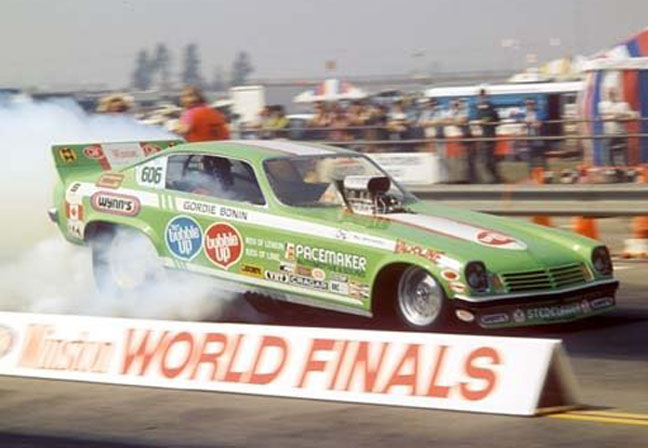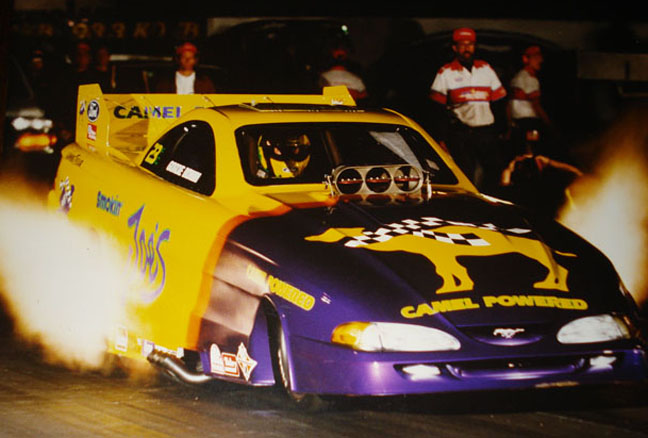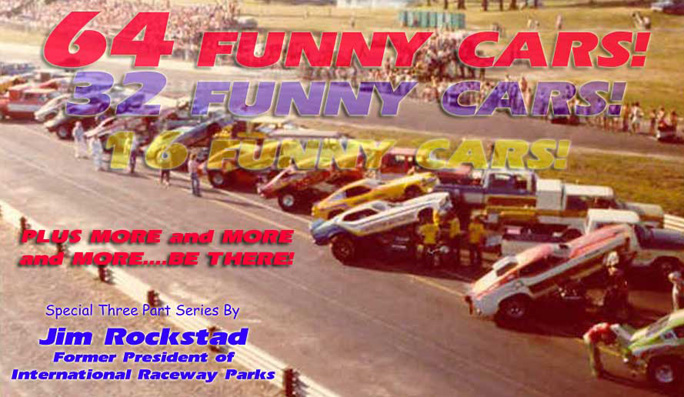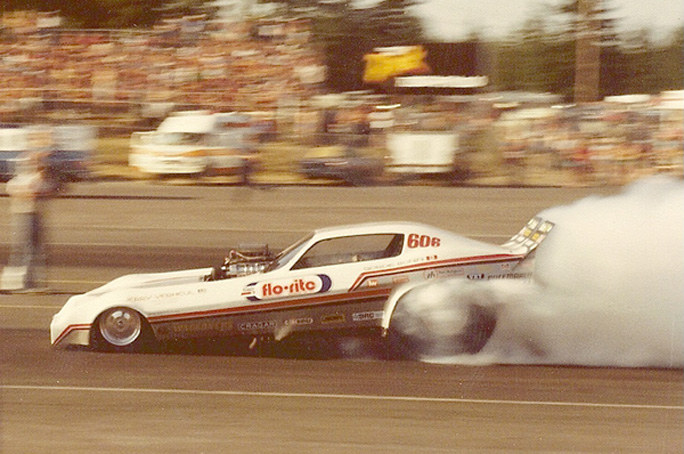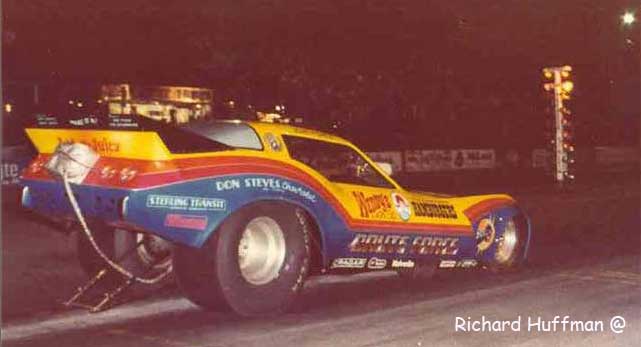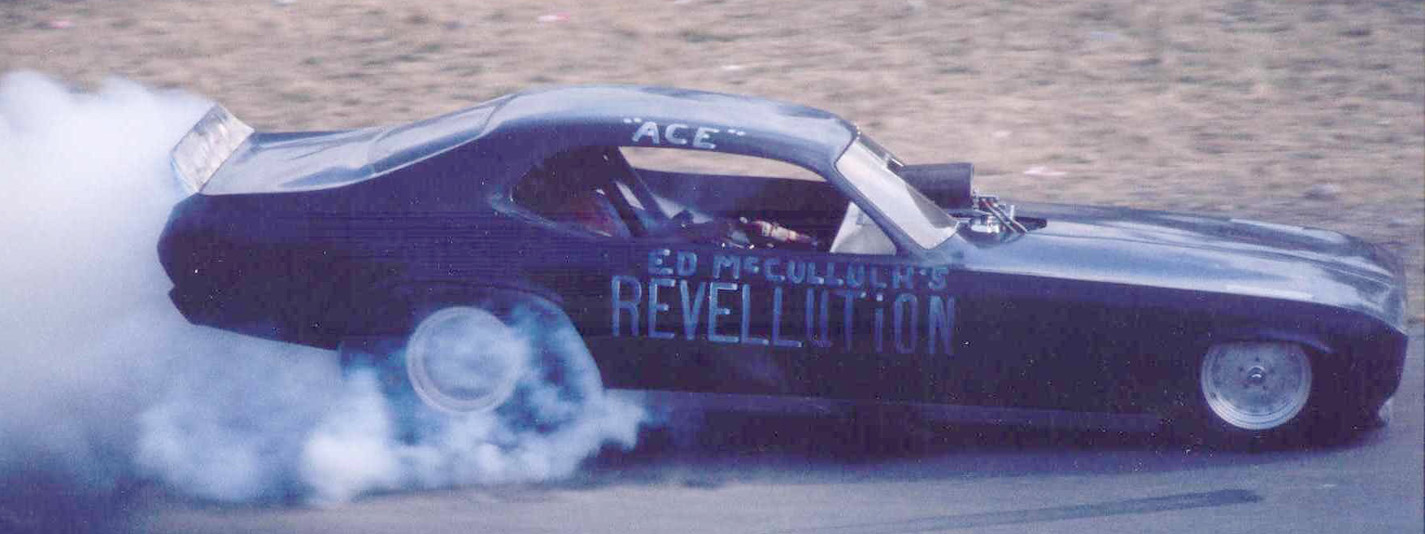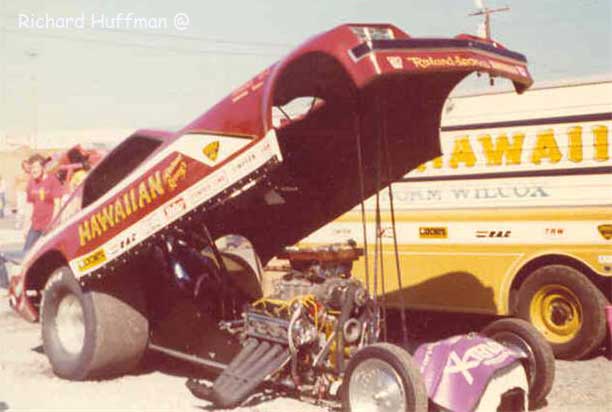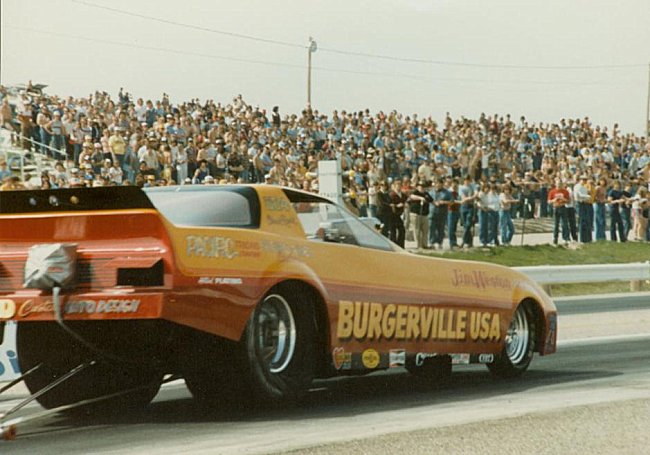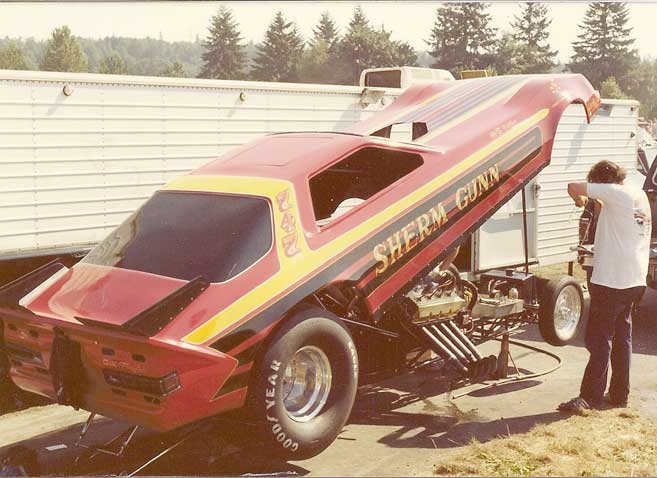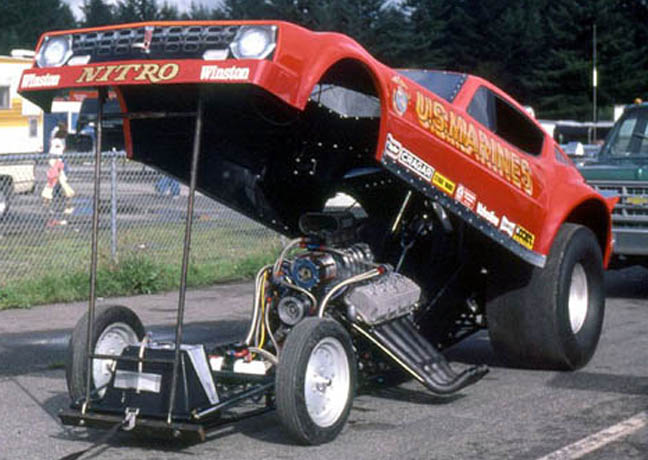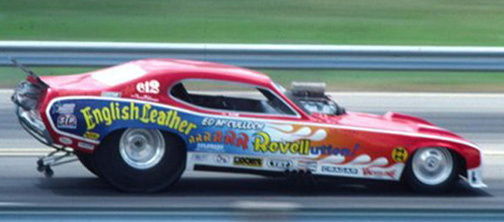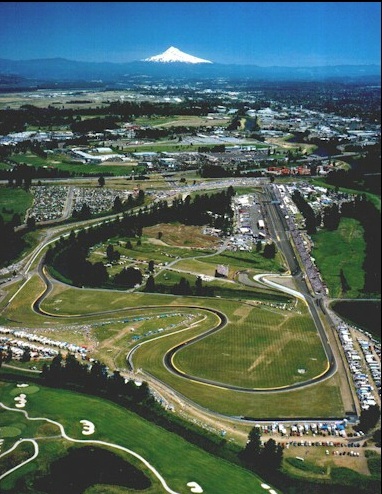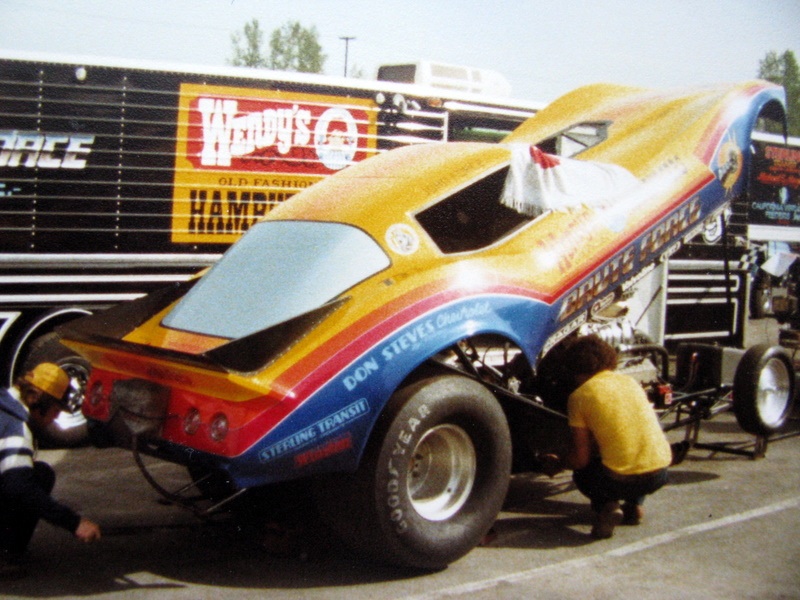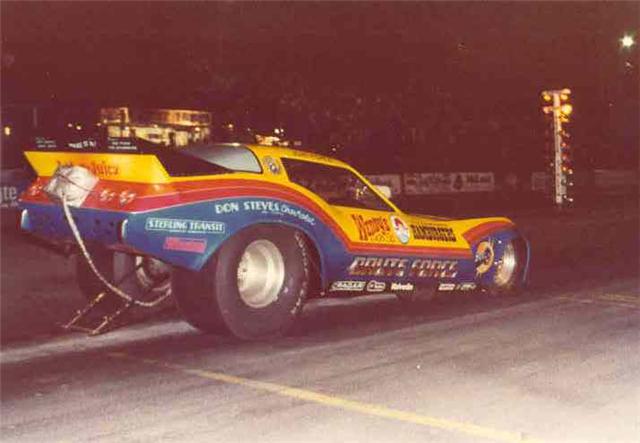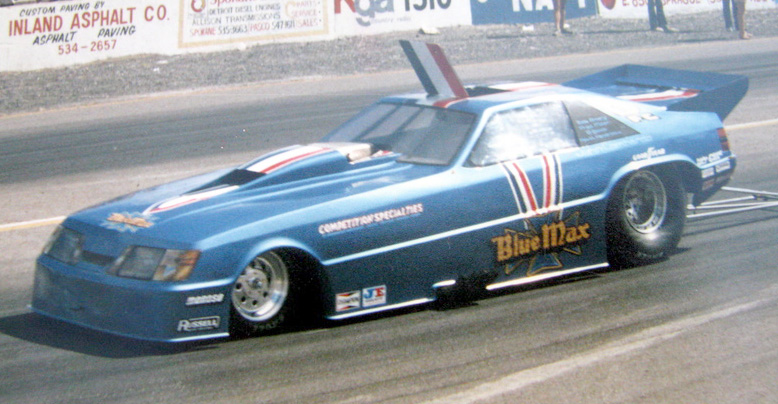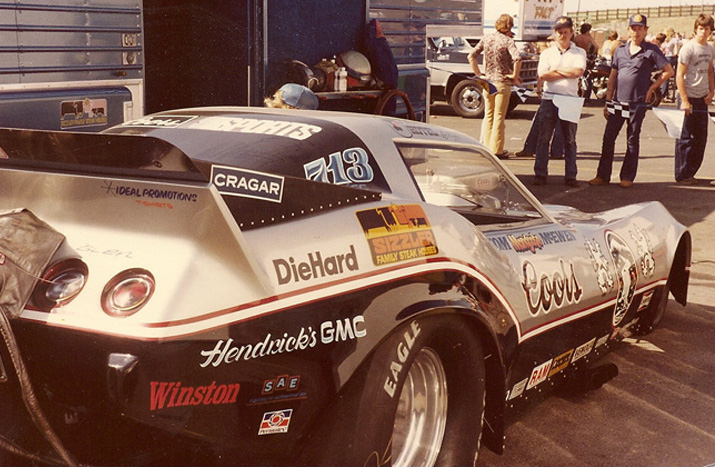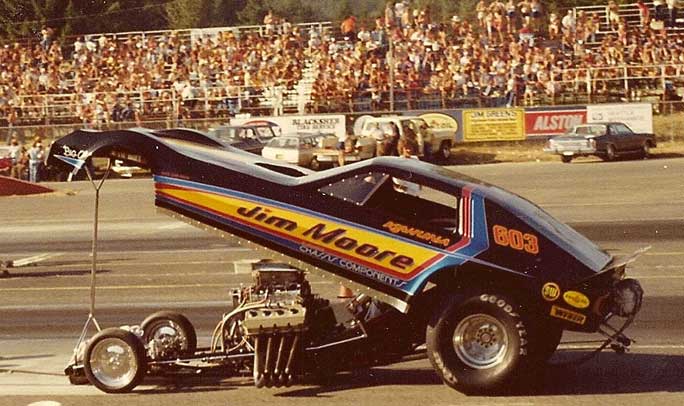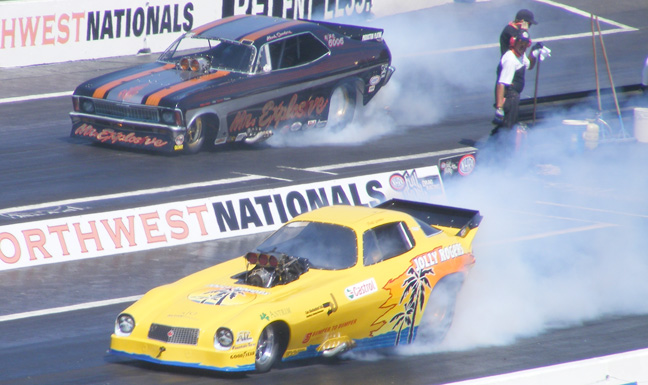
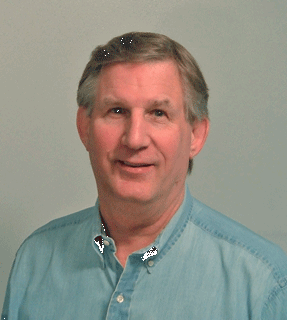 |
|---|
Jim Rockstad |
Welcome to 64 Funny cars, a look at the wild and crazy times of funny car match racing in the 70's. Scroll down to read stories from Jim Rockstad who managed Seattle International Raceway when they stages the giant funny car events. There is also a list of some of the cars that raced at both 32 Funny cars in Portland (before the city fathers wore pink) and then Seattle for the 64 car show one week later. But first an interview 240 Gordie Bonin who was one of the biggest stars from that era.
With Gordie Bonin making a celebrity appearance at the Winter Rod and Speed Show we thought it would be interesting to do an interview with the man himself about his career and what it was like back in the day. We hope you enjoy the first ever interview ever conducted on Cap Racing. Gordie's bio can be found by Clicking Here
Rich: What's your greatest memory?
Gordie: SO many great memories Rich. Winning the 25th Anniversary US Nationals had to be the best. Set the speed record at 246.90, we joined the prestigious CRAGAR 5 Second Club all the same weekend. My 1999 FIA TF tour of Europe was right up there to. Winning the European Championship and going to Monaco to accept my award from Bernie Ecclestone himself.
I've been told I need to write a book.
Rich: I remember driving through Idaho in 1977 with my parents on I-84 and you guys past us like we were sitting still. When you were on the road were you mainly a fly in guy or did you ride with the crew?
Gordie: I was mostly always on the road with Jerry, Steve Hutcheson; Jerry's right hand guy; and Chuck Hagen. I was also working for Canada Dry/Bubble Up in Vancouver BC at the time.
Rich: Did you have a house at the time you were literally living on the road?
Gordie: I lived in Tssawassen, BC
Rich: Was it Ron Hodgson (team owner) or Jerry Verhuel (crew chief) that you owe some of your success too?
Gordie: Both of them. And, Gordon Jenner for choosing me to drive his and Hodgson's funny car; and Jerry for making the horsepower to haul ass.
Rich: It really was a super team between your driving ability, Jerry’s tuning and Ron’s ownership. Jerry was one of the best crew chiefs of that era. I’m sure you miss him.
Gordie: Yes; every day. Great friend and mentor (Jerry past away from cancer. Ed.)
The Bubble Up team after a major victory in Portland. Jerry is in the middle with the bottle.Rich: Did Bubble Up give you a lot of money back in those days?
Gordie: Nope, not much money. Hodgson paid me a small monthly salary, and paid expenses, gas, motels, etc.
Rich: Did the match racing pay the bills?
Gordie: Nope, never paid all the bills.
Rich: Do you consider the win at Indy to be your biggest?
Gordie: The US Nationals 25th anniversary race was the biggest win ever, no doubt. We had our first ever 5 second run; 4th team in the Cragar 5 Second Club, we set the speed record at 246.90 MPH; and won the event. A VERY good weekend
Rich: All in one race?
Gordie: All at one race dude. not all bad, eh?
Rich: Who was your team's biggest rival and was there any one in particular that was a thorn in your side?
Gordie: They ALL were biggest rivals, trust me
Rich: Did you get up for racing Don "the Snake" Prudhomme?
Gordie: Always. Him and ace (Ed McCulloch) got me so tired of looking at their back bumpers. Only them.
Rich: Which track did you like the best? Was it Orange County?
Gordie: All of the west coast tracks were cool. Doner/Evans were the best to race for. Gainesville Florida was very special to us too; winning there 3 times.
Gordie driving the second Pacemaker Vega at Ontario in 1976.Rich: Bill Doner along with Jim Rockstad and Steve Evans were the best promoters, yes?
Gordie: Yep.
Rich: Do you think Bill Doner helped make the drivers into stars with the big radio media buys?
Gordie: Doner made a lot of us stars!
Rich: Do you think the sport is in need of that Bill Doner sizzle now?
Gordie: It sure wouldn't hurt.
Rich: How about US30, the track in Gary Indiana? Was that a scary track to race at?
Gordie: US 30 - we’d stay at the Holiday Inn in Gary and race there on wednesday nights to pay the bills. It had grass between the lanes past the finish line. Spectators would bet BIG every night, who was gonna win. Raymond Beadle (driver of the Blue Max) would go up in the stands and bet before first round.
Rich: I once read that one racer had an agreement to leave before the finals as things would get a little dangerous with those betting in the stands if he didn't win the event.
Gordie: Kuhl & Olson’s Top Fuel car raced there once....they shut off at half track because of a broken third member. A couple BIG dudes from the grandstands made them pull the rear end to show them it was REALLY broken. Scary place.
In addition to driving the Bubble up car, Gordie drove two of the Hawaiian cars and the Smoking Joe's car for Candies and Hughes as pictured above.
Rich; Lets talk about today. You still have great name recognition based on the reaction I’m getting when people hear you are coming to the Winter Rod and Speed Show. Do you get a lot of fan mail from fans around the country?Gordie: Not so much any more; but FaceBook has changed that a lot. I hear from all over the world; even got a good friend I've never met, yet in Italy!
Rich: Do you like the product now (current NHRA funny car racing) or the way it use to be? Do you feel fuel racing is out of hand financially and can it survive?
Gordie: Fuel racing will survive; always. can't comment on where it's going; who knows?
Rich: Have you had opportunities to drive a nitro funny car in the nostalgia class?
Gordie: ya know - yes I did a few years back at the California Hot Rod Reunion. My fireboot stuck the throttle; put her sideways in the burnout; touched the wall; and got her straightened out...
Rich: would you drive again if you were drafted by say Roland Leong or someone like that?
Gordie: People ask me all the time why I don’t drive (the current) Bubble Up car. I tell them because it would never be as fun as it was back then.
Gordie interviewed in Sweeden during FIA championships.
Rich: Lets discuss the FIA for a minute which wrapped up your storied career. What was it like racing over there vs. here?Gordie: It was like here 20 years ago. wonderful people too. Some purpose built race tracks, and some WW 2 landing strips; like Santa Pod England. Google Poddington Air Force Base; rich history; USAF staged their fleet of B-52s there. We met some GREAT RAF folks their too.
Rich: How did the opportunity to race in Europe come about?
Gordie: Prolong Super Lubricants sent me over there as a marketing too when we opened up the European market. Not a bad gig, eh?
Rich: Was the competition tough over there?
Gordie: Yes it was - winning the first two events was huge for me, and Prolong.
Rich: Thanks Gordie for taking the time.
THUNDER IN THE PIPES: Part 1 of a maga - 4 part series
By Jim Rockstad
64 FUNNY CARS: One man’s concept became his legacy – and impacted many others.
With the nostalgic 64 funny car photo presentation on capracing.com coming to a close, there certainly is more to the story than just the cars and the stars.
How could it be that one man could change the sport of drag racing so much that dozens of Northwest racers got into funny car racing?
Just by looking at that long list (by the way, that wasn’t all of them), you could plainly see funny car racing was absolutely the thing to do in the Northwest. No question about it, racers throughout the Northwest took their rides in funny cars.
How did that happen?
"240 Gordie" Bonin was one of the Northwest's most favorite and successful drivers.
Bill Doner, a sportswriter for a southern California newspaper, took over the helm at Pacific Raceways in the late 1960s, attempting to resurrect a racing facility that was just very . . . well, unsuccessful. It was financially unstable with no good events or direction for the future. Doner moved to the Kent area to take on this huge task, first renaming the facility Seattle International Raceway (SIR).
Doner focused on road racing at first, as the other promoters had done, and found little success. One L&M-sponsored event was a major bust for Doner in the early 1970s, resulting in huge losses. He knew he would have to come up with new answers if SIR was going to survive.
Often called “one of the best promoters Northwest motorsports has ever seen,” Doner scheduled a multitude of events at SIR – including one that featured Evel Knievel in a heavily promoted jump that filled the place to capacity. Doner began to understand the Northwest market as he developed his events schedule.
Drag racing was one of Doner’s add-ons in the early days of Pacific Raceways. The drag strip then used the road-course straightaway, going from west to east – the opposite of the current configuration. There were just a few grandstands and facilities for running drag races. Apparently it was an after thought in the original design.
The Unlimited Hydroplanes were the big deal back then, with officials bragging of attracting hundreds of thousands of fans to the shores of Lake Washington . Of course, those were controversial numbers.
It was called Seafair and it included several weeks of events leading to the Hydro races. Doner figured with all of these “race fans” in the area that just maybe he could take the most colorful cars in drag racing and gather them together for a night-race extravaganza (just prior to the boat races) and make a one evening of excitement that would be a huge success. “There is nothing in all of motorsports like nitro funny cars at night,” Doner proclaimed.
So the Seafair Funny Car Championships were born on a Friday evening in the early ‘70’s.
Different than the multi-day national-event drag races, these one-night events were like going to a wild and exciting movie, except it was outdoors, the ground would shake, the smell of nitro would be nonstop and these events unfolded “live,” right in front of your eyes. These floppers provided ground-pounding excitement under the stars at break-neck speed. What a fabulous combination!
In the early ‘70’s there were a few nitro funny cars in the Northwest, but Doner knew he could bring in a few more from Southern California . It was the perfect scenario for local racers because the sport’s biggest names would be coming to their territory, and that made for some exciting racing and great coverage by the local press. There’s nothing like turf wars to generate excitement – and boy, did it!
Although facts are a little sketchy regarding crowd sizes back then, this format was a giant success, bringing thousands and thousands of race fans to SIR. Funny cars at night in Seattle became extremely popular for the race fans and showcased Doner’s superior promotional efforts. This was a completely different approach and other tracks across the country used this cutting edge format with great success.
Ed "The Ace" McCulloch never missed an event. His body even blew of in Portland!
If some is good, more is better!
That was Doner’s motto. Instead of running 16 nitro and 16 alcohol funny cars, he pushed the envelope all the way to 64 funny cars! This was a gutsy move -- almost six solid hours of funny car racing in one evening. Nothing came close to it before . . . or after. The last one took place in 1987.
“There will never be anything like it!” Doner said recently.
Can you believe it? There was so much nitro and smoke from burnouts that a fog would hang over the facility all evening. This event was akin to a battle of the bands or, as some even called it, “Woodstock West.” It was truly showmanship at its very best.
Now that the plan was moving forward, how in the world do you find enough funny cars to pull this thing off? A massive number of cars would have to come from outside the Northwest to fill the field. Would the racers be willing to travel so far to take part in this new concept?
Only time would tell as Doner would “worked” hard to convince one and all that this could be a great success. And Doner can be quite convincing.
Part 2 The best quality event for 64 funny cars will need other events in the area.
Hear one of Bill Doner's Famous Radio Ads:
Firebird Raceway Night Fire Ad
64 Funny Cars: Part 2
64 FUNNY CARS: A quality event needs more than one track to make it work for everyone.
If Bill Doner was going to be able to draw that many cars every year, he would have to get an agreement with Portland to include a smaller version of the event just before the Big One.
The Seattle event’s quality would suffer if other dates weren’t available for the traveling cars. It didn’t take many 64-car events in Seattle to understand that part of the picture – better fields would be a reality if there were other races to attract the best funny cars in the sport.
That picture became a reality in 1973 when the Portland contract became available. Doner signed it and the schedule included a 32-car event the weekend prior to the Seattle race. And now, Doner could get cars from the east …like Jungle Jim Liberman, the Coca Cola Cavalcade, Bruce Larson and Al Segrini, to name a few.
The absolute winners in all of this were the local race fans. Each year, the big-guns in the world of funny cars would arrive in the Northwest in mid-summer. It was known as a “drag racing paradise” for the average fan.
The norm for the east coast racers was to match-race 2-3-4 times a week at tracks several hundred miles apart. But once the 64 funny cars extravaganza in Seattle was up and running, the drivers just had to be there. It became a legend in the sport. To win it was a big deal, and to have it included in your sponsor proposal was a positive move.
Over the years, the logistics of organizing that many cars was overwhelming. In one particular year, funny cars were booked in Eugene, Oregon; Boise, Idaho; Calgary, Saskatoon and Edmonton, Canada; Spokane, Yakima and Portland either before or just after the main event. The impact brought a whole lot of cars to the Northwest and the additional races made it all work.
At the eighth-mile race track in Eugene, Oregon we rented that facility to have an additional event prior to Seattle. The biggest funny car event ever seen by the folks there in Eugene was held the Friday night before 64 funny cars with the Portland 32 car show already completed. Moving all the cars and race crews around got to be pretty massive to get all of these events completed. Quite frankly, there was a little burnout factor that also took place during this time as covering all the details on the production side of these events was a major headache.
Doner’s event changed the entire landscape of drag racing in the Northwest. Talk about major impacts . . . wow!
I recall seeing many funny cars in motel parking lots throughout the Portland-Vancouver area prior to the 32 car event there. The perfect place for Raymond Beadle and the Blue Max was under the Interstate 5 bridge, where they would do a full “field strip” of their racer, after traveling, to get ready for Portland and Seattle back-to back. A curious race fan could spend the whole evening, and a lot did, under I-5 as the funny car teams prepped their cars. Those evenings under the bridge were a show in themselves. You could get up close and personal with “Waterbed” Fred and the guys as they pulled maintenance for the task at hand.
In Seattle, a local band or two were used, starting in the afternoon, to entertain the fans while the cars rolled up on the drag strip. There were two long rows of race cars waiting for the 5 p.m. fire-up. The crowd would do a countdown and the “thunder in the pipes” (familiar name) would take over. It was sort of an extremely loud sign that mid-summer had arrived in Seattle.
The standing room-only throng would cheer in unison as the monstrous motors fired up in concert with a salute to the “Big One”. The noise was near-ear shattering when that many motors came alive at the same time.
Ed McCulloch would drive his car back to the pits with a little extra showmanship along the way – and the crowd cheering him on. Of course, “tire cleaning” would have to take place along the way and the fans would stand to show their appreciation for the “Ace”.
Along with the massive noise, the track looked like downtown Seattle in 5 o’clock traffic. The jam of cars wouldn’t allow the cars to move very far. It was a mad scramble to get back to their individual pit spots. And the confusion only added to the energy exhibited by the massive crowd.
Different than the normal drag race program the Chicago-style approach was used. All the funny cars would run two rounds. Win or lose either round made no difference as the elapsed times of the two quickest cars allowed them to move into the final. By the time one round of the cars was complete and a little jets and wheel standers were thrown in the mix, it would be round two…ready to go. Two complete rounds of all the cars would take over 4 hours, a pair at a time…..every few minutes!!
At 5:30, the cars were lining up in the staging lanes readying for that first round and the electricity in the air was without compare. Once the National Anthem was completed, Doner always came right at them with the opening salvo, and always with some of the best racers in the field. That move would set the pace and excitement level for the rest of the evening.
Pair after pair after pair of cars came to the starting line and added burnouts past the eighth mile, one of the hallmarks of this event. The crowd would go nutso. It was all part of the show.
Wall-to-wall funny cars racing followed for well over five hours. Jet dragsters and wheel-standers would fill any void to stay in tune with the non-stop action. There wasn’t much time to get a hot dog and a Coke because the action was hot and heavy, hour after hour. You were lucky to be able to catch your breath between runs.
Later in the evening, as the sun set in the West, the headers would begin spewing out the flames well above the bodies of the race cars. As earlier stated, a fog of tire smoke and nitro fumes would literally cover the race track giving an eerie feeling to the nighttime action. Those sweet smelling nitro fumes would be thick in the air, along with those eighth mile burnouts continuing for hours, in those cool Seattle evenings. It was a sight, along with sounds that, could only be seen at 64 funny cars.
THUNDER IN THE PIPES: Part 3, One key to the success was Doner radio commercials
Hear one of Bill Doner's Famous Radio Ads:
Firebird Raceway Night Fire Ad
64 FUNNY CARS: One key to the whole success was the famous Bill Doner commercials
What would all of this excitement be with some laid back radio spots telling the folks where to spend their hard-earned dollars? That would never work as you have to give them the feel of what they will miss if they don’t go to the event. You gotta put them on the edge of their seats wherever they are, at that moment, so they are ready for the big-league action coming up. That was Doner-style, make no mistake about it.
Doner even taped part of one of the commercials at Portlands’ event. He had the entire crowd yell, “SIXTY FOUR FUNNY CARS”…..so he could use it in the Seattle commercials. Talk about smart moves as everyone in that Portland facility knew about the larger event coming up in just one week, less than 3 hours up I-5. Crafty, eh?....that’s Doner. What a brilliant promoter.
The “Big One” in Seattle contained more excitement than most people can even handle. That is where the famous Bill Doner radio commercials came in. Phrases like “fiberglass forest”, “trick traction compound”, “under the lights” and of course, “ground pounding”……..all of these descriptive words came from his commercials telling the folks you gotta BE THERE! One commercial even warned, “You will regret seeing the Monday morning headlines having not attended the event”. Mass hyperbole, for sure, but oh, so very, very effective.
The hyped-up Doner commercials were very controversial but they also were very successful. If you didn’t like them you talked about them a lot. That’s called success when people are talking about your brand all the time.
A perfect example of one of the “media blasts” with these exotic commercials was in Portland after the 1973 contract was signed with the city on PIR. The big rock station in town back then was KISN. Doner and I set up a meeting with Bill Failing, General Manager of KISN to lay out the media buys for the summer. When it actually came down to locking in the buys Doner said, “can we buy a spot an hour?” (that really means will you allow one advertiser to dominate your airwaves.”) Failing said yes and Doner said, “we want to buy one spot an hour for 10 days prior to our event.” Failing just about fell off his chair. Talk about massive saturation of the market, nobody does that….well, almost nobody.
We bought a few other radio stations there in Portland but the KISN buy was targeted perfectly and quite frankly, massively. For a week and a half it seemed like that was all you heard was Doner and these wild and crazy radio commercials in the Portland area. What a huge introduction to the Doner commercials. They were the talk of the town no matter where you went. People loved them….well, most people did.
At the time, there wasn’t any advertisers even coming close to buying so many radio spots in a market so Portland were “bombed” with drag racing-mania coming to PIR, in big-league style. There was nothing conservative about Doner and his approach to promoting events. He had an exciting product that he had confidence in and he let the whole world know about….over and over again. He certainly was out there blowing his horn and in his very own voice
Later when the NHRA National event was to return to SIR in 1988 I insisted on using the Doner commercials for their events also. They didn’t go along with that very easily but I kept the pressure on and they finally agreed to go along with that approach. I felt very strongly that drag racing and Doner ads were so very important to be together that it was paramount for the return of the NHRA to Seattle.
To this very day, I still hear mentions about those old commercials from different sports
broadcasters all these years later. The energy in them fired up those that were looking for exciting action and 64 funny cars was certainly that. Doner would paint the listeners a picture of what the event would be like and 64 funny cars would deliver “in spades.”Over the years the event drew praise from the who’s who of the sport: The legendary
Midwest promoter Ben Christ who ran a funny car race of his own at US 30 had heard
so much about the famous Seattle event he had to see it for himself. Standing on the SIR starting line in his Lime Green pants, shirt and shoes said, “I’ve never see anything like it”. “Rock bands, thousands and thousands of people and then they line all the cars up on the race track and have some guy leap over all of them on a motorcycle with a hand glider attached.”Don Prudomme, in a recent interview in Pomona told an audience, “THAT was some real serious ground pounding in Seattle”. The Snake loved coming to the Northwest for 64 funny cars and so did a whole list of other front-line stars.
The largest event ever held at SIR was the NAPA Regal Ride sponsored 64 funny car event in 1979. After 26 straight hours of ticket sales, beginning at 6pm Friday, the attendance finally ended up with over 26,000 jammed into the raceway on Saturday evening. The overflow traffic backed up for over 5 miles on the local highway. It’s the only time that I have seen in my lifetime where ticket sellers could actually work two different shifts, with sleep in between, for the same one-day event….and we needed everyone we could get.
My efforts were mostly involved with the ticketing back in 1979 at that event. With that big of a crowd coming to SIR it would take a “shoehorn” to get them all in there. In those days the drive-up ticket booths were located on the entrance road to SIR. In early afternoon a dilemma took place, the parking lots were jammed throughout the facility and we had many hours left prior to the first round of the event.
Then, finally, we had complete and total gridlock…the cars backed up to the ticket booths and no more selling could take place. “Now what do I do?” There was a whole new set of problems than I had ever dealt with at SIR. I kept thinking to myself that these new problems will require new thinking to solve or deal with them.
With race fans waiting in their cars in lines that seemed to never end I knew there had to be someway to allow the congestion to subside so there could be some movement. It was multiple lanes wide and solid from the parking lots to nearly the local highway….and that had a reported 5 miles of backup. There just has to be a safety valve here somewhere.
I grabbed a motorcycle and had security line up cars behind me in the left (exit) lane. As I rode the motorcycle straight to the pit area the cars would follow along as I knew there was lots of room in there. I did that same plan over and over again with hundreds and hundreds of cars….they would buy their admission tickets and then line up behind me and the motorcycle as I escorted them directly into the pits. They must have felt like they were VIP’s getting an escorted trip right directly into the pit area.
It just seemed to me like that was the only way to solve the massive backup. I had been involved with 6 or 7-64 funny car events over the years and nothing even came close to this one.
Part #4: Getting them into the event was only part of the problems
64 Funny Cars: Part 3
Decision Time has ArrivedBy Jim Rockstad
At Seattle International Raceway, just prior to the 1988 season, we negotiated a long-term contract for the first-ever NHRA Northwest Nationals. The previous NHRA National event at SIR was held from 1975 through 1980 and always held during the month of September. (in those early times it was the only place on the NHRA schedule that would fit for Seattle). Over those previous 6 years, rain had taken place on 4 of the events, meaning it never really got established in Seattle, its’ success was really in question. For 7 straight years after the event left in 1980 SIR was without an NHRA National event…..the main attraction was the continuing 64 funny car event….which certainly was not a bad thing.
The NHRA expanded the National event schedule on the west coast for 1988 which included two new event locations, Seattle and Sears Point (now Infineon Raceway). That adjustment by adding in Sears Point opened up the middle of summer and what is now called the Western Swing; three National events in a row including Denver. Finally, there was a mid-summer west coast schedule for the NHRA.
The NHRA Northwest Nationals in Seattle was scheduled for the first weekend of August and that meant changing the location on the calendar for 64 funny cars after a long run of 16 years on that weekend. That certainly was something I really didn’t want to do. The well-established, early August date for 64 funny cars would need to move to some other location on the annual SIR schedule. I knew from the start that changing that event to another location during the summer would not be an easy thing to do.
I certainly wanted to continue our “most important event” but the date would have to be moved to some other location and that can be a real problem in the Seattle market. One of the hardest things track operators do is schedule events so they don’t conflict with other events in and around the local area…and, in some certain cases, there needs to be no conflict with the NHRA National event schedule.
To maintain a quality event the relocation for 64 funny cars would require a non-conflicting position so that there would not be an NHRA Nationals anywhere in the country that weekend. And then there is always much concern about the weather in the Northwest. The second-best location (first weekend of August is number one) was the last weekend in June as the NHRA didn’t have a National event in late June at all back in those days. The percent of possible rain goes up significantly in late June and the financial risk can be a huge concern. One good rainy weekend for that event can eliminate the whole thing and the financial hardship can be big-time for the company.
I was very apprehensive of even doing the event again in 1988 but I did not want to stop
the most amazing event that race fans have ever seen. There must be a way to continue.I recall the rain that fell on the one-day 64 funny cars in 1976 which made for a real mess…including a major trauma for the financial side of the company. Doner had purchased and installed a huge grandstand from Sick Stadium at SIR just prior to the 64 funny car show. Sick Stadium was an old major league ball field in Seattle that was selling off everything and with the continuing growth of 64 funny cars grandstands were certainly needed. (I took over as General Manager of SIR 2 months later after the huge project of the grandstand installation and the rain on 64 funny cars had taken place….a multitude of problems were all ahead!!)
The major undertaking not only took the whole spring and summer to install but the costs of the project were monstrous. In those days most grandstands were mostly wood with a steel frame, which made for a lengthy and costly installation. A huge crew was working day and night around all the racing at SIR for many months. It was either the first or one of the very first giant grandstand installations into a drag strip. I remember NHRA President Dallas Gardner saying to me, “There isn’t another track in the country that has grandstands this size….the grandstands of this size, here at SIR, are the very first”.
I decided to make it a three-day event knowing that it wouldn’t have the impact that it had as a Saturday night only event but if a little rain showed up we could probably get the event done during the longer time period. As the NHRA continued to expand its National event schedule every few years, we all knew the future of 64 funny cars was really limited. Some day they would complicate the matter so bad that 64 funny cars would not be able to exist mostly because of the smaller “weather window” of the Northwest. The best, most reliable weather is located the last weekend of July and that first weekend of August. Outside of that schedule location the rain chance goes up significantly.
The modern-day NHRA schedule has, in some cases, National events on three weekends out of four in some months. It would be harder these days to even attempt to work around their schedule to get the necessary cars. Back in the 70’s and 80’s the NHRA had less than half the National events that they now have. For 2009 the NHRA even had 4 in a row on their schedule.
It has become nearly impossible to produce a huge event like 64 funny cars when you are competing against the NHRA for cars. In these instances the NHRA is, no doubt, our biggest competition.
I continued to sort through the information to see what made the most amount of sense on if I should go forward or should I not even try to continue 64 funny cars. It was the toughest decision I had to make at SIR.
64 Funny Cars: Part 4
64 FUNNY CARS: is there Enough Cars?
As I continued wavering back and forth in a decision to convert 64 funny cars to a different format and then move it to a different location on the on the SIR schedule, there
were a lot more pieces to the picture I needed to analyze..Another part of the equation that needs to be considered was complicated by the fact that Portland International Raceway could no longer have any major drag races there after 1986. That wonderful, park-like, close-in PIR location that allowed for easy access and large crowds also impacted the area with loud noise. After about 15 years or so of pressure from the local neighborhoods, the City of Portland eliminated major drag races in 1986. All the smaller e.t. bracket races there must have mufflers on all the race vehicles and they still do to this day. (Editors Note: even the Capitol Dragster got the boot at a race that had a noise variance)
When the end came for the 32 funny cars in Portland it hugely affected the 64-car show in Seattle. Attracting the best cars was getting really hard to do after the major races stopped in Portland that year.Even local funny cars had been drying up as the lesser events were causing the lack of income to offset the ever-rising racing costs. More cars would need to come from a long ways just to fill the gaps in the field. Of course, longer traveling means more costs for the event and the risk continues to rise.
With the arrival of the sparkling new NHRA Northwest Nationals in 1988 on the traditional time slot of 64 funny cars, I had to get a new location that made sense, for a 3-day concept of that event.
I felt the 3-day approach was worth a try because I didn't’t want to lose the event that made Seattle its’ name. I thought there was a chance, maybe small, that I could convert a traditional one-day into a 3-day event, move it on the schedule and have something totally different in Seattle. Most of these major events take quite a bit of time to get established and the future of such an event was not exactly clear.
Deep-down I feared the NHRA would continue on the path of expansion which would just push this 3-day event out of the picture. As long as it didn't’t rain for 3 solid days it would be worth trying to salvage a future for 64 funny cars at SIR. I knew I could learn a lot with this very first try…..and I sure did!
Back in the 70’s and 80’s, contracts with racers were few and far between. During the winter, a racer and the promoter would exchange phone calls to lock-in a schedule for the next year. Over-the-phone deals were mad
e and the racers would show, make the necessary runs and the promoter would compensate the racer, as per the verbal deal. Pretty simple-or, at least, it would seem if no complications arise.
In some cases, prior to the season, the professional racer would make a verbal commitment to race at a particular event and then would begin gathering points at the NHRA events early in the season. By the time mid-summer rolled around it would become obvious to the racer that continuing to gather NHRA championship points was a smarter move and so some cancellations would take place. They felt they had a possible shot for the NHRA World Championship and so 64 funny cars in Seattle was losing its’ meaning to them. Why not just skip the event altogether?
Those efforts complicated the promoters’ plans to produce a major race with the best cars available. I remember in one instance where a letter from an attorney had to remind the racer that a verbal deal is valid and lawful and that then changed the mind of the pro racer as he was considering to renege on his deal with the track. After analyzing his choices and weighting the risks this racer decided to compete at 64 funny cars as promised. A little leverage was required to protect this huge event in Seattle.
For the 3-day event 1988 64 funny cars at SIR, we had verbal deals with Raymond Beadle and the Blue Max along with John Force, as two of the cars for the “Big Show”.
In his early years, Force was a match-race guy, often scheduling as many events as possible in each week…no matter where they were. As I recall, he had booked his funny car in Englishtown, N.J. the weekend prior to our late June event in Seattle. It would be a coast-to-coast tow for Force and his team. Talk about a grueling schedule, I had never heard of anybody doing that long of a tow.Understand that it was just gut wrenching during that entire week with radio and television ads blaring away about John Force coming to Seattle and me knowing that he was coming from that far for our event. I had plenty of sleepless nights that week I just had to ask myself, “What would happen if their truck blew a motor and they didn't make it to Seattle on time?” I tried not to think about that too much. Can you imagine how much heat we would get if Force didn't make it…ugh! I would have had to hide under my desk during the whole event!
64 FUNNY CARS: Part #7 Moving forward with the new format…..here goes.
John Force and 64 Funny Cars: Part 5, The Final InstalmentMoving forward with the new event…..here goes.
By Jim Rockstad
Making deals with the professional racers was, often times, a little tough to do for 64 funny cars. There were always the stories about the high cost of nitro…or traveling that far is too costly or what if it rains? Some of the pros acted like Seattle were somehow located next to south Alaska and so the costs of just getting there was way beyond their means. It seemed like they always needed more money. Negotiating the deals was always a balance between what we could do and what the racer needed…..often times, that was far, far apart.
With John Force there was always some humor that made things a little easier to deal with him. He is Mr. Supersales and he hustles every deal that he gets…..and I do mean “hustle.” During the week, he phoned me three or four times from the roadside and wanted to renegotiate the deal because the truck permits was costing him a fortune as he commuted across the continental USA. I remember one call from the Kansas area as he was leaving the truck weight station with his famous mouth going a hundred miles per hour, “Rockstad, I’ve got to have more money. All these truck permits are killing me!” I told him to just “GET HERE” and we’d work it out.
The good part (if you call it that) of all the calls was I knew he was holding up the bargain and that he would make it. He was getting closer and closer with each phone call. Understand also, Force always honored his deals. I had complete confidence that he would arrive in Seattle and put on a great show…he was known for that.
Later that week, the raceway secretary handed me the phone and said, “It’s Force, of course,” as he had entered Washington State. I took a huge breath of relief as he had more than enough time to pull it all off. I told him we’d talk about his “deal” when he arrived.
When Force finally arrived at the race track on Friday, he looked like he had walked all the way across the U.S. He was a whipped puppy, that’s for sure. I got concerned that he might not be able to drive the race car as he looked so exhausted, but somehow he gathered enough strength to get it all together, as he probably had done many, many times before. In these early days of his career you could see his passion to make it in this sport….he was not going to let anything stop him from competing at a scheduled race.
I had always felt good about him showing up but, then again, he might not have traveled all the way across the country to make it to Seattle before.Force always knew that if he didn’t make a “verbal deal event” that it would affect his ability to get match-race type events…the word would get out and the events would dry up. That has been the case with many racers over the years. Your word is only as good as your performance getting to and running at the track. Once that falls apart in those old match race days, you can just bet that track operators across the country will take a “hands-off” approach to booking in a certain racer.
As a promoter, the last thing you want or need is for your number one car to not show up.
That is a dilemma that none of us want to go through
During his qualifying on Saturday, Team Force broke a drive line and couldn’t make the call when the funny cars were supposed to run. (a rare occurrence for him). Later, after all the cars had run, Force did make a run, just to cover the “deal”, after making repairs to the drive train. Because he didn’t run at the scheduled time due to the broken drive shaft, he was at a disadvantage in his “deal” at the end of the event.
As I recall, I did increase his show up dollars as I could easily understand that having a race car driver drive the full length of the USA doesn’t make a lot of sense for either party. Driving from coast-to-coast in a few days time certainly didn’t make sense to him as I could plainly see how worn out he was.
It was so very obvious to me after this tedious time that I wouldn’t continue with 64 funny cars again. Attempting to book in all of those cars who have to travel so far could only lead to disaster for them or leave our Seattle event without the quality lineup the event was known for since 1972. After 17 years of ground pounding excitement, 1988 became the final year of the event that meant so much to so many…64 FUNNY CARS!
I just hated to see it go away!
THUNDER IN THE PIPES: Snake and the rare photo—“flammin” through the lights
Sixty Four Funny Cars!
OUR PICK FOR THE KING OF 64 FUNNY CARS...
Jungle Jim was to drag racing what Led Zepplin was to rock music
Jungle Jim was the ultimate showman! Jungle would do crazy things that seperated him from his competition. There were long quartermile burnouts, there was the foxy Jungle Pam backing him up. There were other antics as well including firing up the car in the pits and then driving it down to the end of the track and then idle it from the top end to the starting line in Portland. Jungle didn't win a lot of races and in fact won only once in Englishtown at the NHRA Summernationals. Still, he was a promoters dream and was match racing's biggest draw until his death in the late 70's when his Corvette street car hit a bus on a city street. The test of time proves that Jungle is a legened to this day. Had he not died it's likely that he would still be out there today as a car owner or possibly still a funny car racer just like John Force!
So how does Jungle Jim compare with Led Zep? Good question. Both peaked in the same era. Led Zep was the biggest band at the time but really didn't have a hit record to their credit. Jungle Jim was the biggest draw in drag racing but didn't win a lot of national events. Both Jungle and Led Zep had the same kind of entourage and wild life style if you get my drift.
Below is a list of cars that raced in the northwest. Some are the same drivers but all are different cars. A special thanks to those who wrote in asking for pics of the cars they missed!
64 Funny Cars that raced in the Northwest....
Car #1 The Powergloss Hawaiian Monza, Los Angeles CA, 1976
Car #2 The Jam Air Special Olds, Los Angeles CA, 1985
Car #3 Mr. Auto Supply Omni, Marrysville WA, 1981
Car #4 Mountain Dew Citation, Los Angeles CA, 1984
Car #5 Insanity Corvette, Los Angeles CA,1985
Car #6 Condit Bros Arrow, Los Angeles CA, 1980
Car #7 Bubble Up Firebird, Edmonton Canada, 1979
Car #8 Klampe and Lewis Vega, Salem OR. 1979
Car #9 The Jean Machine Arrow BB/FC, Portland OR. 1982
Car #25 Tommy Ivo, Dodge Duster, Hollywood CA. 1977
Car #11 Whiskey River Corvette BB/FC, Portland OR. 1982
Car #12 The Green Elelphant Vega, Seattle, WA. 1977
Car #13 Springer and Price Vega, Eugene OR. 1975
Car #14 John Collins Tom McEwen's #2 Duster, Los Angeles CA,1976
Car #15 Teacher's Pet Monza, Los Angeles CA, 1976
Car #16 Wheeler Dealer Mustang, Edmonton Canada, 1977
Car #17 The Blue Max Mustang, Dallas TX. 1977
Car #18 The Olympia Beer Mustang, Seattle, WA. 1981
Car #19 Jim Moore Arrow, Ancorage Alaska, 1978
Car #20 Jim Dunn, Omni, Los Angeles CA, 1980
Car #21 Nitro Nick's US Marines, Arrow, Portland OR. 1980
Car #22 Twig Zeigler, Mustang, Pendelton OR. 1978
Car #23 Tom McEwen, Coors Corvette, Los Angeles CA, 1982
Car #24 Larry Palmer, Plmouth Satellite, Portland OR. 1977
Car #25 Showtime Firebird, Minniapolis MN, 1985
Car #26 John Lindsey's Inpulse Mustang, Los Angeles CA. 1982
Car #27 Romund's Chariot Vega BB/FC, Canada. 1978
Car #28 Alky Motion Omni BB/FC, Portland. 1982
Car #29 Don Prudhomme's Skoal Bandit, Granada Hills CA 1987
Car #30 Tom and Jerry Luppy Mustang II, Linnwood WA 1977
Car #31 Fuelish Pleasuse Mustang BB/FC, Medford OR 1979
Car #32 Steve McGee, Monza BB/FC, Lake Oswego OR 1978
Car #33 Richard Day, Cuda BB/FC, Southern CA 1978
Car #34 Richard Smith Firebird BB/FC, Kansas City MO 1981
Car #35 Minor Bros. Olds TA/FC, Lodi CA 1985
Car #36 Brad Anderson, Trans Am, TA/FC, Southern California, 1984
Car #37 Pat Austin, Ford Probe, TA/FC, Tacoma WA, 1983
Car #38 Ed McCulloch, Miller Olds, Hemet CA, 1992
Car #39 Jim Epler, Trans Am,TA/FC, Vncouver WA, 1988
Car #40 Rich Rodgers, Dodge Duster, Seattle, 1976
Car #41 Dean Rowley, Washington, 1976
Car #42 Tom Tillett,TA/FC, Washington, 1989
Car #43 Ray Beadle's Blue Max, Dallas, 1983
Car #44 Lil John Lombardo, Arrow, Sherman Oaks CA, 1983
Car #45 Ladies First, Monza, Southern CA, 1982
Car #46 Chris Chrstiensen, Arrow BB/FC, Southern CA, 1979
Car #47 Ed Grekul, Camaro BB/FC, Edmonton Canada, 1981
Car #48 Ed McCulluch's Revellution, Dodge, Fresno CA, 1978
Car #49 John Force's Wendy's Corvette, Yorba Linda CA, 1978
Car #50 Chuck Byrd's Burgerville Firebird, Portland OR
Car #51 Super Shops Arrow, Orange County CA, 1980
Car #52 Dale VanGundy's Quarter Pounder bb/fc, Southern California, 1981
Car #53 Sherm Gunn, West Covina CA, 1985
Car #54 Jim Moore, Omni, Alaska, 1981
Car #55 Marty Maltais, Aberdine WA, 1981
Car #56 Nitro Nick Harman, Firebird, Portland 1981
Car #57 Gordie Bonin, Flo-rite Firebird, Edmonton, 1981
Car #58 Bill Dunlap's Capt. Crazy TA/FC, Omni, Southern Califrnia, 1981
Car #59 Jerry Ruth's Mustang, Seattle WA, 1975
Car #60 Roland Leong's Hawaiian Monza, Southern Califrnia, 1975
Car #61 The Revell Snowman Vega, Dallas Texas, 1975
Car #62 Chuck Beal, Arrow, Southern CA, 1978
Car #63 Gary Densham, Datsun, Southern CA, 1981
Car #64 Our Pick for the best...Jungle Jim, Monza, Pennsylvania, 1978
64 Funny Cars Really Returns to Seattle?
A rumor floating around suggests that Pacific Raceways in Seattle is going to book a 64 funny car show. The problem is where will they find all the cars especially with NHRA's tight rein around the nitro cars that can no longer match race due to the testing ban. I guess they would all need to be nostalgia cars as there are more of those these days anyway which might make for a better show anyway. They seemed to hold their own at the Northwest Nationals (pictured) Did our 64 funny car special have anything to do with this idea?
Directory |
|---|
Updated Jeff Lauener Tribute A tribute to our Crew Chief |
Don Garlits |
| The Blue Angels Photos by John Lingerfelt |
Ernie Hall |
| Northwest Nitro A scrap book look past Northwest Funny Cars |
| Thunder in the Pipes Archives By Jim Rockstad |
|

